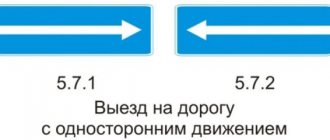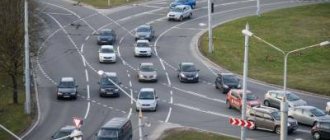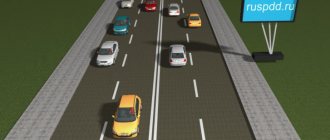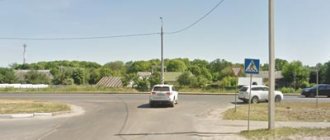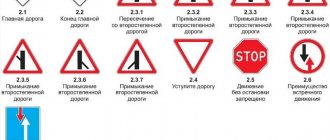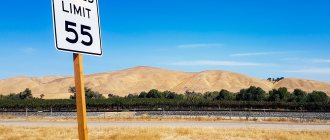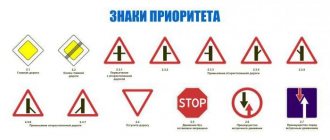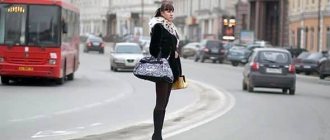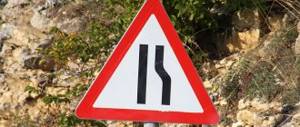Symbol meaning
The “One-way traffic” sign is installed in front of the road, along the entire width of which the movement of any motor vehicles must be carried out in only one direction. Externally, the symbol is presented in the form of a square, with a white arrow on a blue background. Some drivers commit serious violations by confusing it with the mandatory “Go straight” sign. Visually, the symbols are similar, but the latter is presented in the form of a circle with an arrow enclosed in it. It is important to distinguish between them, since they imply compliance with different rules.
A one-way traffic sign marks the beginning of a roadway on which all vehicles must travel in the same direction. In addition, it is also installed at intersections. Namely, at the intersection of parts where at least one road is “single-stream”. In this situation, the installation of the sign is due to the fact that drivers entering this area must timely assess the situation and follow the Traffic Rules.
Other signs
The sign with the arrow pointing up is not the only one indicating one-way zones. Other graphic designs are also installed on roadways.
These include:
- Sign "Exit onto a one-way road." Designed for drivers traveling on another roadway. This sign informs them that they are approaching the start of a one-way road. Moreover, it can be seen at an intersection if at least one section being crossed needs to move in one direction. It is important to pay attention to the direction of the arrow. This is the direction you need to turn. Accordingly, you cannot move in the opposite direction. In this case, you will enter the lane intended for traffic in the opposite direction.
- "End of one-way road" sign. Externally, it is the same square and a white arrow depicted on a blue background. But the sign is crossed out with a red line. This symbol is installed at the end of a one-way roadway. It is needed so that drivers can assess the situation and promptly change lanes to the outer lane, so as not to accidentally end up in a lane intended for cars moving in the opposite direction. As a rule, the sign is installed together with the warning symbol “Two-way traffic”.
There is always a sign on the back side of the road called “No Entry,” better known to drivers as a “brick.” Ignoring this symbol in many cases leads to an accident. This is due to the fact that inattentive drivers enter a one-way road, but from the other end, that is, they find themselves in the oncoming lane.
One-way traffic sign
Roundabout sign
Paragraph No. 5 of the Traffic Regulations provides for a number of signs of special regulations. Among them is "One Way Road".
It says that in a particular area only one direction is acceptable. In its coverage area, movement to the left, right, straight and in reverse is allowed.
"5.5.6. Sign 5.5 “One-way road” is used to designate a road or carriageway along which the movement of vehicles across its entire width is carried out in one direction, and is installed at the beginning of the road or carriageway.
The sign may not be installed:
— at the beginning of exits at intersections at different levels, driveways to service facilities where one-way traffic is carried out;
- at the beginning of a one-way roadway, separated from a roadway with oncoming traffic by a dividing strip or boulevard, on roads with separate routing, in cases where visibility of the roadway with oncoming traffic is ensured from each of the roadways.
Repeated sign 5.5 is installed after intersections with complex layouts.”
GOST R 52289-2004
There are also a number of signs that clarify the boundaries of the one-way area.
| Sign | Photo | Name | In what cases is it installed |
| 5.7.1 | Entering a one-way road | Before any side exit onto the roadway where sign 5.5 is in effect. May be absent only in those places where exit is only possible from a road where sign 5.5 is already in effect. These signs are located above others located on their side. | |
| 5.7.2 | |||
| 5.6 | End of a one way road | It is installed at the end of the section where sign 5.5 was in effect. | |
| 1.21 | Two-way traffic | Installed 50 or 100 meters before the start of the road with traffic in one direction. Outside cities and villages, this distance can be increased to 150-300 meters. Not installed if the scope of sign 5.5 is terminated by a roundabout or T-junction or square. |
After sign 5.6, the left side of the roadway automatically becomes oncoming, only if there are no special instructions from signs 5.15.1, 5.15.2, 5.15.7, 5.15.8. Most often, next to sign 5.6 there is sign 1.21.
Coverage area
You must move in one direction until the corresponding sign appears, canceling the previous one. In this case we are talking about the symbol “End of a one-way road”.
In addition, the sign is valid until the nearest intersection. If a driver is driving along an area that has several roadway intersections, then he should know that on the other side the symbol is no longer relevant. In other words, beyond the intersection, the person driving the vehicle has the right to make certain maneuvers, which are prohibited by default by the “One-way traffic” sign.
Basic signs “One-way traffic” and traffic rules for them
The “One-way road” sign means the beginning of a segment that can be followed strictly in one direction, regardless of the location of the car on the lanes. And it is unacceptable to move towards traffic traveling in the indicated direction.
5.5 is not the only sign that can be seen on such a road. There are other signs that tell drivers what the limit is. The one-way traffic signs in the traffic rules are as follows:
- 5.7.1 and 5.7.2. They show the exit from another trajectory onto a road where it is only allowed to go “there”, but not back. The conditions they establish are the same as those dictated by 5.5.
- 3.1. Imposes an entry ban. It is installed across the street from 5.5. The symbol refers to vehicles that might tend to drive in the opposite direction of the permitted one.
- 5.6. Notifies that the territory where 5.5 was active has ended. And, moving further, the driver can see oncoming traffic. Next to 5.6 there is sometimes a sign 8.1.1, indicating the distance to the road, where cars move in both directions.
- 1.21. Placed at the beginning of a segment where it is allowed to follow in both directions. There may be a 5.6 symbol with it, but not always. If the area regulated by 5.5 is no more than 100 m in size, 1.21 is installed alone.
- 5.11.1 and 5.11.2 . The first one is located where all vehicles are traveling in the same direction, and only route vehicles are traveling towards them. The second means that only cyclists are allowed to move in the oncoming lane. This lane is closed to others.
More on AutoLex.Net:
Designation options and features of passage to the “Bicycle path” sign: beginning, end of the path
Entry into and exit from the symbol's coverage area
On a single-lane road, special rules apply. They are easy to remember. But, despite this, in reality, very often people driving vehicles have difficulties when entering and exiting a given area.
When the “One-Way Road” sign appears, it is recommended to change lanes to the right. This is the optimal way to travel. In addition, the need to perform certain maneuvers automatically disappears.
In some cases, the following difficulties arise:
- The one-way traffic sign is located behind the intersection, which can only be reached by turning right. In such a situation, you need to leave the intersection and change lanes. In other words, turn right as you would under normal circumstances. After this, the driver has the right to drive on any lane of the road intended for one-way traffic.
- The sign is installed at the left turn. In this case, the algorithm of actions is similar to that described above. Just before starting the maneuver you need to change lanes to the far left.
- Tram tracks are located along the route. In such a situation, access to a one-way road must be made from them. But the vehicle must not interfere with trams. In addition, the maneuver cannot be carried out if there are signs prohibiting it. It is also important to ensure that you do not accidentally end up on tram tracks intended for the opposite direction.
- When leaving a one-way road, you must turn left. To do this, you need to change lanes in a timely manner. However, it is important to remember that until the intersection, traffic continues to be one-way. It is when this maneuver is performed that the largest number of violations are recorded.
It is important to remember that the “One-way traffic” sign is located at the beginning of the right lane of the roadway. It is designed for drivers who continue to drive straight. Or they intend to make a right turn.
In what directions are you allowed to move?
| 1. | Just straight ahead. |
| 2. | Just straight and to the right. |
| 3. | Only straight, left and in the opposite direction. |
| 4. | In any. |
In this situation, the traffic controller does not change the existing traffic organization at the intersection. If you are in the right lane, you can only drive straight through the intersection, as the sign “Entering a one-way road” prohibits turning right. To make a left turn or U-turn, you had to take the left lane.
Movement in forward direction
All drivers are required to comply with the terms of the mandatory symbol. Regardless of which “One-way traffic” sign is installed (the beginning of the zone or the exit to this area), the person driving the vehicle must move in the direction indicated on the arrow. That is, in this case, driving in a forward direction is the best option. But there is one caveat. It is important to carefully assess the situation so as not to end up in the lane intended for traffic in the opposite direction.
Fine for driving onto a one-way road
The amount of punishment for an administrative offense depends entirely on the degree of its severity. The fine for driving onto a one-way lane in 2021 is five thousand rubles or deprivation of rights for a period of 4-6 months (Article 12.16 of the Administrative Code). When choosing a lane for route vehicles, the sanction provides for the recovery of one and a half thousand rubles (Article 12.17 of the Administrative Code). The fine for driving in reverse at an intersection is five hundred rubles (Article 12.16 of the Administrative Code).
When maneuvering in the opposite direction, the motorist faces two main troubles:
- hitting a person;
- collision with a moving or standing vehicle.
The responsibility will be on the motorist, since he was not convinced of the safety of his actions. According to this, the culprit will face a fine in 2019 for driving on one-way traffic in the opposite direction under Article 12.14 of the Code of Administrative Offences. In case of similar movement on the highway - according to Art. 12.11. Code of Administrative Offences. If, while driving in reverse, an accident involving another vehicle is caused, the court will clearly consider the main culprit to be the one who made the ill-considered maneuver. The injured motorist in an accident is also fined if he did not adhere to the rules.
Right turn
In this case, several scenarios are possible:
- The driver should not encounter any difficulties when exiting a one-way road. You must first move into the outer lane and make a turn.
- The driver needs to turn right within the area of the sign. In such a situation, you also need to take an appropriate position and drive into the adjacent territory, for example, into a yard.
Thus, right turns are not prohibited in the area covered by the One-Way Traffic sign. Drivers should not be afraid to carry out this maneuver either at intersections or on less busy roads.
What trajectory can you continue moving along?
| 1. | For any reason. |
| 2. | Only according to A. |
| 3. | Only by A or B. |
At this intersection there is a sign “Exit to a one-way road”, which does not prohibit movement straight and to the right. When turning, you should move as close as possible to the right edge of the roadway. Consequently, movement at the intersection can only continue along trajectories A and B.
Left turn
The “One-way traffic” sign prohibits this. This is a rule with no exceptions. If the driver is moving in a straight direction, he cannot turn left, since in this case he will inevitably end up in the oncoming lane. This significantly increases the risk of an accident. In addition, the violator in such situations is subject to administrative liability. As practice shows, most often the driver’s license is confiscated from the person driving the vehicle.
U-turn
This maneuver is also prohibited. This is due to the fact that a driver who turns around will end up in a lane intended for vehicles moving in the opposite direction.
A different situation arises if a person is driving along the road and sees a sign “Exit to one-way traffic.” In this case, two scenarios are possible. The driver has the right to turn right and be within the area of the sign. The start of one-way traffic means that the person can no longer turn around or turn left. He must move in a straight direction or go to the right.
In the second case, the driver may not enter a one-way road. In such a situation, he can easily make a U-turn. This issue causes disagreement among many drivers. They are due to the fact that when turning, the vehicle will inevitably end up in oncoming traffic. However, you need to understand that a turn is a maneuver. It does not imply driving in the oncoming lane. Therefore, this is not a violation.
What signs allow you to make a U-turn?
| 1. | Only A. |
| 2. | B and V. |
| 3. | All. |
Sign 3.18.2 “Left turn prohibited” (A) prohibits only a turn, but not a U-turn. Sign 5.7.2 “Exit onto a one-way road” (B) and sign 5.13.2 “Exit onto a road with a lane for route vehicles” (B) also do not prohibit turning around at the intersections of such roads.
Stopping and parking
Drivers have the right to park on both the right and left sides of the roadway. But this is only when we are talking about a populated area, and there are no corresponding prohibitory signs.
Trucks weighing more than 3.5 tons are prohibited from parking on the left side of the roadway. They can only stop for the purpose of loading/unloading. If there is a lane on the roadway designated for the movement of route vehicles, all vehicles are prohibited from parking on the left side. Outside the populated area, the roadside should be used to stop or park. Parking is only permitted on the right side of the roadway.
"No Stopping" and "No Parking" signs
Drivers confuse these signs even more often than the “brick” and “No traffic” signs, since they are similar in appearance. We are talking about road signs “Stopping is prohibited” (traffic rules sign 3.27) and “Parking is prohibited” (traffic rules sign 3.29).
In essence, one road sign prohibits any stopping of a vehicle, while the other allows a vehicle to stop, for example, to disembark or load passengers, but for no more than 5 minutes, since over this time, according to the law, stopping a vehicle will already be considered parking. Despite the fact that many drivers often confuse these two signs, they are very easy to remember. Just remember that the cross means that you cannot stop in any situation.
For reference, a quote from the traffic rules:
The coverage area extends from the place where the sign is installed to the nearest intersection behind it, and in populated areas, in the absence of an intersection, to the end of the populated area. The effect of the sign is not interrupted at exit points from areas adjacent to the road and at intersections (junctions) with field, forest and other secondary roads in front of which the corresponding signs are not installed.
Reverse
When entering the beginning of a one-way road, many drivers are afraid of the sign. It is important to remember that the symbol prohibits U-turns and left turns. Reversing is allowed. But before performing this action, the driver must make sure that he will not interfere with other vehicles.
The most striking example is the following: a motorist accidentally passed the entrance to the yard on the right and does not know whether he can put the car in reverse and then move into the adjacent territory. This action is permitted and does not entail administrative liability. But first you need to make sure that it is safe to do so.
The situation is different with intersections. At any road intersections, reversing is strictly prohibited. If the driver has passed the desired section, he is obliged to move in a forward direction until it becomes possible to turn right.
Administrative responsibility: penalties
This issue is regulated by the Code of Administrative Offenses (Article 12.16). If a driver violates traffic rules in the area covered by a one-way road sign, he faces a fine. Its size is 5 thousand rubles.
An alternative penalty is the confiscation of the driver's license for a period of at least 4 and maximum 6 months. If the violation is repeated, the driver’s license may be revoked for 1 year.
The choice of punishment is made by the court. In most cases, this authority decides in favor of withdrawing the driver's license.
What trajectory can you use to make a turn?
| 1. | Only according to A. |
| 2. | Only according to B. |
| 3. | For any reason. |
In this case, a U-turn is prohibited only directly at the pedestrian crossing (trajectory B), the boundaries of which, in the absence of markings, are determined by “Pedestrian crossing” signs. At the intersection (trajectory A), a U-turn can be made, since the “Exit onto a one-way road” sign does not prohibit a U-turn.
